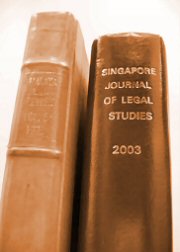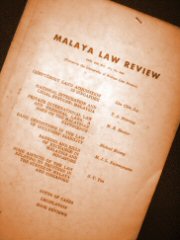| 541. | JULY 2005 Issue | p.150 |
|
|
| Fissures in the Façade of Fair-Dealing: Users' Rights in Works Protected by Copyright
Ong, Burton • [2005] Sing JLS 150 (Jul)A significant part of the copyright regime is premised on a delicate balance being stuck between the rights of those who create works for commercial exploitation and the interests of the audience of "users" for whom those works were created to edify, engage and entertain. In view of the increasing pressures from copyright owners seeking to fortify the nature and scope of their exclusive rights, what role do the courts play in restoring balance to the copyright system through the way they interpret the statutory defences to copyright infringement? This article will evaluate a recent attempt by the Canadian Supreme Court to widen the scope of the "fair dealing for private study or research" defence, which has traditionally been applied restrictively, in a way which suggests that "users" of copyright works may have a stronger claim to make copies of these works than was previously thought.
|
| 542. | JULY 2005 Issue | p.159 |
|
|
| Multiculturalism and Accommodative Liberalism Revisited
Ramraj, Victor V • [2005] Sing JLS 159 (Jul)In an earlier volume, I argued that state policies based on ethno-racial essentialism were undesirable and that accommodative liberalism provided a commendable alternative, enabling states to take seriously the need for ethnic groups to protect their cultural institutions and respective identities without resorting to essentialist assumptions. These arguments have since been subject to critical scrutiny by Lim Chin Leng in his essay, "Multicultural Constitutionalism." I respond to Lim's criticisms, arguing: (a) that accommodative liberalism takes group rights seriously and does not collapse into atomistic individualism; (b) that accommodative liberalism can protect group rights without resorting to essentialist assumptions; and (c) that despite its parochial origins in western political thought, accommodative liberalism dies have something to contribute to the wider debate about multicultural policy, even in Southeast Asia. Accommodative liberalism, I argue, represents a plausible attempt to construct a "big tent" - a flexible approach to pluralism and tolerance in diverse societies.
|
| 543. | JULY 2005 Issue | p.170 |
|
|
| Cambodia and the Right to be Present: Trials in Absentia in the Draft Criminal Procedure Code
Starygin, Stan and Selth, Johanna • [2005] Sing JLS 170 (Jul)This paper analyses Cambodia's proposed new criminal procedure laws in relation to trials in absentia. Cambodia has always allowed trials in absentia, since its colonial days, but it is argued that recent developments in other states and in international law and practice limiting trials in absentia should be followed in Cambodia. It is argued that trials in absentia in Cambodia are likely to infringe upon the human rights of Cambodian citizens, and that they are prima facie no longer acceptable to the international community unless strict requirements are adhered to. The government of Cambodia should take into account international law, as well as its own Constitution and treaty obligations, when deciding whether the continuation of trials in absentia are appropriate for the country. The paper also analyzes potential conflicts between Cambodia's criminal procedure law and the international standards that must apply to Cambodia's special court to try former Khmer Rogue leaders, the Extraordinary Chambers. The repercussions of this conflict are discussed.
|
| 544. | JULY 2005 Issue | p.189 |
|
|
| A Note on the Application of the Statute Law of Singapore Within its Private International Law
Briggs, Adrian • [2005] Sing JLS 189 (Jul)[Full Text]
|
| 545. | JULY 2005 Issue | p.204 |
|
|
| Loss of Chance - A Lost Opportunity?
Fordham, Margaret • [2005] Sing JLS 204 (Jul)
|
| 546. | JULY 2005 Issue | p.218 |
|
|
| The Constitution and the Reception of Customary International Law: Nguyen Tuong Van v. Public Prosecutor
Lim, C. L. • [2005] Sing JLS 218 (Jul)
|
| 547. | JULY 2005 Issue | p.234 |
|
|
| Reverse Engineering the New Reverse Engineering Provisions in the Copyright (Amendment) Act 2004
Seng, Daniel • [2005] Sing JLS 234 (Jul)
|
| 548. | JULY 2005 Issue | p.246 |
|
|
| Chester v. Afshar: Stepping Further Away from Causation?
Khoury, Lara • [2005] Sing JLS 246 (Jul)
|
| 549. | JULY 2005 Issue | p.261 |
|
|
| Intention and Unlawful Means in the Tort of Conspiracy
Chan, Kok Yew Gary • [2005] Sing JLS 261 (Jul)
|
| 550. | JULY 2005 Issue | p.270 |
|
|
| A Falcon Takes Flight: The Anti-Deprivation Principle and Corporate Groups
Chan, Tracey Evans • [2005] Sing JLS 270 (Jul)
|
|







